Push to Program Liberty Plaza, Library Lane
Ann Arbor park advisory commission meeting (Aug. 19, 2014): Liberty Plaza was the focus of two items that appeared on PAC’s Aug. 19 agenda: (1) extension of a fee waiver for events held at Liberty Plaza; and (2) feedback in response to city council action, which addressed Liberty Plaza and the potential park atop the Library Lane underground parking structure.
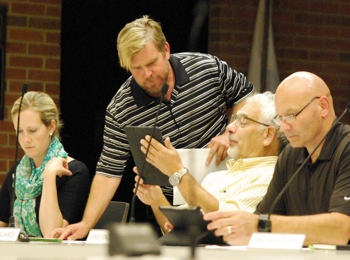
From left: Paige Morrison, Colin Smith, Bob Galardi and Graydon Krapohl before the start of the Aug. 19, 2014 Ann Arbor park advisory commission meeting. (Photos by the writer.)
Regarding feedback on Liberty Plaza and Library Lane, PAC unanimously passed a resolution to form a subcommittee to study issues related to those urban parks, and to allocate or obtain resources to oversee programming there for up to a year.
Based on that effort, the subcommittee would analyze the outcome and deliver recommendations to council next year – no later than October 2015. This resolution, drafted by PAC chair Ingrid Ault and vice chair Graydon Krapohl, had been emailed to commissioners earlier in the day but was not available to the public prior to the meeting. [.pdf of Aug. 19, 2014 Liberty Plaza resolution]
The Aug. 19 discussion also included comments from Matthew Altruda, who programs the Bank of Ann Arbor’s Sonic Lunch weekly summer concert series at Liberty Plaza. Ault had invited Altruda to the meeting to describe that effort, which is widely cited as a successful use of Liberty Plaza.
Regarding the fee waiver, PAC voted unanimously to extend the waiver through October 2015 – coordinating with the subcommittee work on Liberty Plaza and Library Lane.
Both Aug. 19 items – the feedback to city council (but with no accompanying resolution) and fee waiver – had originally appeared on PAC’s July 15, 2014 agenda, but were postponed because three commissioners were absent at that meeting.
In other action, PAC recommended approval of three three-year professional services agreements (PSAs) for engineering services in the parks and recreation unit – with SmithGroupJJR, Stantec Consulting Michigan Inc, and Tetra Tech Inc. The amount was not to exceed $150,000 annually per agreement.
The commission also elected David Santacroce as chair for the coming year, replacing Ingrid Ault in that position. Paige Morrison was elected as vice chair. Each vote was conducted by “secret ballot” as stipulated in PAC’s bylaws. The one-year terms begin Sept. 1.
One topic that did not appear on PAC’s Aug. 19 agenda was a review of the proposed four-year extension on a University of Michigan lease of three parking lots at Fuller Park. The city council – at its meeting the previous night, on Aug. 18 – had indicated an interest in having PAC take another look at the lease renewal, but parks and recreation manager Colin Smith told commissioners that he didn’t have additional details on the request.
During deliberations on Aug. 18, mayor John Hieftje had recommended postponing council action until early October, in order to give PAC two meetings during which they could reevaluate the lease agreement. PAC had already recommended approval of the lease, after discussing it at their July 15, 2014 meeting. The parliamentary option chosen by the council was to postpone, not to refer to PAC.
The two council representatives on PAC – Mike Anglin (Ward 5) and Christopher Taylor (Ward 3) – chose somewhat different points of emphasis in their characterizations of the council’s Aug. 18 action on the Fuller Park lease. When Anglin told commissioners that the council wanted PAC to review the lease again, Taylor stressed that the council action was “a straight postponement” – not a vote to refer the item back to PAC. He added that the council was interested in hearing if PAC has any further thoughts on the use of the site.
Liberty Plaza & Library Lane
Two items on the Aug. 19 agenda related to Liberty Plaza: (1) extension of a fee waiver for events held at Liberty Plaza; and (2) feedback in response to city council action, which addressed Liberty Plaza and the potential park atop the Library Lane underground parking structure.
Both Aug. 19 items – the feedback to city council (but with no accompanying resolution) and fee waiver – had originally appeared on PAC’s July 15, 2014 agenda, but were postponed because three commissioners were absent at that meeting.
After July 15, however, PAC called a special meeting for Aug. 5 to begin their discussion on providing feedback to the city council on Liberty Plaza. PAC’s discussion on Aug. 19 was informed in part by a packet of material provided to commissioners at that Aug. 5 special meeting, which The Chronicle was not able to attend because it was the date of primary elections. [.pdf of Aug. 5 Liberty Plaza packet] The materials included a memo with background and a bulleted list of issues related to Liberty Plaza, a list of potential ideas to address these issues, and suggestions for next steps.
Also included were PAC’s downtown parks recommendations, and a summary of previous work related to downtown parks, such as results from surveys conducted by the Ann Arbor Downtown Development Authority’s Connecting William Street study and by PAC’s downtown parks subcommittee. The packet also included case studies from downtown parks in four other communities: Director Park in Portland, Oregon; Arcadia Creek Festival Place in Kalamazoo; Campus Marius Park in Detroit; and Katz Plaza in Pittsburgh.
Commissioners continued that discussion on Aug. 19, focused on a newly crafted resolution that had been drafted by PAC chair Ingrid Ault and vice chair Graydon Krapohl. [.pdf of Liberty Plaza resolution, as amended by PAC on Aug. 19]
Liberty Plaza & Library Lane: Background
The PAC resolution discussed on Aug. 19 responded to a city council resolution that had been considered at the council’s June 16, 2014 meeting. That council resolution had been brought forward by Christopher Taylor (Ward 3) – who serves as an ex officio member of PAC – as well as mayor John Hieftje, Margie Teall (Ward 4) and Sabra Briere (Ward 1).
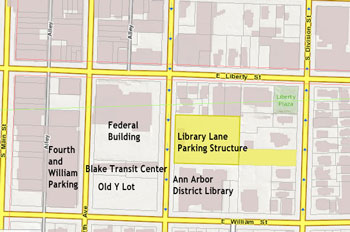
Liberty Plaza is highlighted in green. The surface of the Library Lane parking structure is highlighted in yellow. The city council has designated 12,000 square feet of that lot, on the west side along the South Fifth Avenue, as a future park.
The original version of Taylor’s resolution would have directed the city administrator to “work collaboratively with the property owners adjacent to and near Liberty Plaza, the general public, PAC [park advisory commission], the Ann Arbor District Library, and the DDA to develop a conceptual design for an improved Liberty Plaza…”
But after nearly an hour of debate on June 16, the council voted to refer the resolution to PAC instead of approving it. The vote on referral to PAC came amid deliberation on some amendments to the resolution proposed by Jane Lumm (Ward 2) that would have broadened the scope of the effort to include the Library Lane lot. [.pdf of Lumm's amendments]
Funding for the collaborative work on the redesign, in the amount of $23,577, was specified in the proposed resolution as coming from the parks and recreation budget. In addition to a concept for a “re-imagined Liberty Plaza,” the resolution was supposed to result in options for funding construction, to be provided by city staff. Taylor’s resolution called for a report to be provided to the park advisory commission by December 2014 and to the city council a month later in January 2015.
Taylor’s resolution came in the context of a push by some Ann Arbor residents – including members of the Library Green Conservancy – to establish public park space on top of the underground Library Lane parking garage, which is southwest of Liberty Plaza separated from that park by a surface parking lot owned by First Martin Corp.
Related to that, the council voted at its April 7, 2014 meeting – as part of reconsidering a vote it had taken at its previous meeting on March 17 – to designate a 12,000-square-foot portion of the Library Lane surface to be reserved as an urban park. The result of the reconsidered resolution on April 7 undid the council’s earlier decision to establish a square foot range for the urban plaza – from 6,500-12,000 square feet. That April 7 council decision was made on a 7-4 vote, with dissent from Taylor, Hieftje, Teall and Chuck Warpehoski (Ward 5).
Deliberations among councilmembers on June 16, 2014 included questions about why PAC hadn’t been consulted on the resolution on Liberty Plaza. Taylor indicated that it wasn’t necessary to consult PAC, as it’s the council’s prerogative to set policy. PAC’s regular monthly meeting had been scheduled for June 17 – the day after the council meeting – but it was canceled.
PAC had previously been directed by the council to develop a set of recommendations regarding downtown parks, which were completed last year and included recommendations for Liberty Plaza and the Library Lane site. The council accepted PAC’s recommendations at its Nov. 7, 2013 meeting. [.pdf of 21-page PAC downtown parks report]
Liberty Plaza & Library Lane: Public Commentary
Two people spoke about this topic during the first opportunity for public commentary at PAC’s Aug. 19 meeting.
Ethel Potts told commissioners that she watches their meetings on Community Television Network. “You haven’t seen me, but I see you,” she said – a comment that drew laughs. The city council has given PAC an assignment to do something with Liberty Plaza, she noted. But the council has tied PAC’s hands by limiting the planning to Liberty Plaza. She described the plaza as “orphaned public space, unconnected to anything else in that whole block.” It used to connect to the lower level of the adjacent building, owned by First Martin Corp. on East Liberty, Potts said. Now, that building seems to be mainly offices, she added, with “very little coming and going of people.”
Potts thought the plaza’s design is charming, with two features that every park should have – shade and seating. However, to be a success it needs to connect to the downtown library, to the future park on Fifth Avenue [on top of the Library Lane underground parking structure], and to the bus station. She noted that someday, there will be a building over part of the Library Lane structure.
Liberty Plaza needs to have a connection, “so that it isn’t just left out there on a corner on its own,” Potts said. “I would ask you to please disregard the limits put on your planning by council.”
The idea of connecting Liberty Plaza with the rest of that block is supported by the Ann Arbor Preservation Alliance, which is very concerned about the historic buildings on Liberty and Division in that same block, she said. Liberty Plaza itself is becoming historic, she concluded.
Ray Detter said he was speaking on behalf of the downtown citizens advisory council. Most of the July DCAC meeting was devoted to a discussion of the future of the “library block,” he said – particularly Liberty Plaza and the future park on top of the Library Lane parking structure. With the former Y lot now sold and a broker hired to explore the sale of development rights on the Library Lane site, “we should all be ready to plan a great urban space on that entire block,” Detter said.
Members of the DCAC support development of a significantly-sized public plaza on the South Fifth Avenue side of the Library Lane site, Detter said, as well as use of Library Lane all the way up to the parking structure entry for scheduled community activities. DCAC also supports pedestrian walkways. All future development should take into consideration the needs of the downtown library, possible connection to the Blake Transit Center, the University of Michigan credit union site, the former Y lot, and nearby historic properties, businesses and residents, he said.
DCAC also supports a new tax-producing private or public development on the major part of the Library Lane site – a development that would provide “eyes” on a future adjoining public plaza, Detter said. In April, he noted, the city council resolved that the city would work with the developer of the remaining portion of the Library Lane site to ensure that the design serves both spaces. A lot of work and outreach has been done to develop integrated planning, he said, “and I think it’s time we really use it.”
Detter noted that the DCAC was involved in the 1991 Luckenbach/Ziegelman study, as well as with the 2005 Calthorpe study and more recently the DDA’s Connecting William Street study. All of these studies support a vision for the entire block and area, he said. “Connecting Liberty Plaza and the proposed Library Lot plaza have always been a major part of that plan,” he said. No money should be spent on redesigning Liberty Plaza unless it’s a part of that broader vision. He hoped that any money spent would be used for programming on Liberty Plaza. Events such as Sonic Lunch and Magic Carpet Mornings have proven that with the right programming, Liberty Plaza can be a downtown asset, he said.
Saying that PAC might have forgotten it, Detter recalled that about 10 years ago a group had formed called Friends of Liberty Plaza, which raised $250,000. The DDA agreed to give $250,000 if the city parks department gave $50,000, Detter said. Ron Olson, the city’s park director at that time, agreed to that. So there were major improvements made then, he said. However, he added, “we did not eliminate the problems that the park still faces today. We think we can do that with a comprehensive plan for the entire park.”
Liberty Plaza & Library Lane: Commission Discussion
PAC chair Ingrid Ault began the discussion by noting that both of the city councilmembers who serve on PAC – Mike Anglin and Christopher Taylor – were running late. She hoped that Taylor especially would arrive in time to participate, because he had sponsored the council resolution that PAC would be discussing. [He arrived about 30 minutes into the discussion.]
Colin Smith, the city’s parks and recreation manager, pointed out that the council did not vote on Taylor’s original resolution or on amendments proposed by Jane Lumm. Rather, they referred the resolution and amendments to PAC for consideration and feedback about costs and a timeline.
Ault apologized to commissioners, noting that they had not been sent her draft two-page resolution until earlier that day. It had turned out to be more complicated than she’d anticipated. She said the last page was the most important, and she then read it aloud:
Whereas, placemaking principles specifically identify the importance of dedicated and sustained programming resources as vital components of successful urban public spaces,
Whereas, dedicated and sustained programming resources have not historically been allocated in direct support of Ann Arbor urban parks, especially Liberty Plaza,
Whereas, PAC recommends the formation of a subcommittee to study and specifically address the issues associated with urban parks, especially Liberty Plaza and the Library Lot,
Whereas, PAC recommends that prior to any resource being allocated for redevelopment efforts directed at planning and redesign of either Liberty Plaza or the Library Lot, that resources, human and material, be allocated or obtained to specifically oversee the programming of Liberty Plaza and the Library Lot for a period not to exceed one year in order to answer the following questions:
1. Determine costs for on-going dedicated resources (human and material) for programming of the spaces for one year, recognizing that key element for success of any urban park is sustained and meaningful programming of the space.
2. Determine the success of programming efforts and how the currently designed spaces function in support of that programming. What worked and didn’t work?
3. Determine at the end of the study if issues long associated with Liberty Plaza are a function of design or the absence of sustained and meaningful programming, or a combination of both.
4. If shortcomings are design related, does it warrant a partial or complete redesign based on the outcomes of the study?
5. Determine what role adjacent and near by properties (public and private) have along with other downtown neighbors with regard to Liberty Plaza in determining key stakeholders for ongoing discussions.
NOW THEREFORE, BE IT RESOLVED, to reaffirm the purpose of PAC is to provide for public involvement in community park and recreation services and to provide advisory recommendations to the Manager of the Department of Parks and Recreation, City Administrator and Council regarding parks administration,
BE IT FURTHER RESOLVED, that PAC recommends that Council accept the above recommendations and direct staff and PAC to answer these questions and report their findings no later than October 2015.
Ault said that she and Krapohl had forgotten to include what funds would be designated for this purpose, so the resolution would need to be amended for that.
This would be a big undertaking, Ault said, so the timeframe was very important. It’s not something that could be done in the timeframe indicated by the council resolution – January 2015. She noted that PAC’s downtown park subcommittee had worked for nine months to complete its recommendations.
Pushing back the timeframe would allow PAC and staff to use the fall and winter to come up with ideas for programming, which could be implemented in the spring and summer, she said. The results of that programming then could be reported to the council in the fall of 2015. “You can’t make improvements unless you know how [the space] functions currently,” Ault said.
Liberty Plaza & Library Lane: Q&A with Matthew Altruda
Ault reported that she had asked Matthew Altruda to attend the Aug. 19 meeting and share his observations about what works or doesn’t work at Liberty Plaza, based on his experiences programming the Bank of Ann Arbor’s Sonic Lunch weekly summer concert series.
Altruda briefly described the history of Sonic Lunch, saying that the bank’s president, Tim Marshall, had wanted to sponsor an event that used music to build community. “We believe music is one of the great chariots of building community. When you’re out seeing music and dancing with someone, that’s where you meet your great friends and future husbands and wives – it really brings the community together.” He pointed out that in the movie “Braveheart,” the only time the characters are enjoying themselves is when they’re dancing around the fire.
Sonic Lunch is a huge event and it takes a lot of time, Altruda said. This summer is the seventh season for this series, and any event that someone tries in a city park needs to be given a few years to get off the ground. “We are in the fruits of our labor now, with great turnouts and the city really embracing us,” he said. It’s extremely difficult to make a new Ann Arbor tradition.
A lot of people understand the “non-programming” that goes on in Liberty Plaza, Altruda said – some people talk about how it’s a place where homeless people hang out or where drug activities occur. In his experience, when the Bank of Ann Arbor staff shows up, the people who are hanging out at Liberty Plaza usually leave. First and foremost, these are people in the Ann Arbor community, Altruda said. “We treat them with respect, and when it’s time for us to do our programming in the park, they return that respect and leave.” If they don’t leave, they “act like great citizens and enjoy the music like everyone else,” he added.
Ault said that one thing PAC learned when they studied downtown parks is to focus on behavior, not on particular groups of people. She thanked Altruda for reminding them of that. “Everybody has the right to use a public space, until behavior encroaches,” she said.
Paige Morrison asked Altruda to elaborate on obstacles that Sonic Lunch has faced. Altruda replied that some of it relates to reassuring families about the safety of Liberty Plaza. Early on, there was an issue with people panhandling, he said. So some confidence had to be built to assure visitors that the park was safe.
“A lot of people fear the unknown, and when they walk by the park, they’re thinking that there’s terrible people there doing terrible things,” Altruda said. “I think that’s an unfair thought to have for these people.” There are definitely some “bad apples” who hang out at Liberty Plaza, he added. But others have started to police themselves, he said, if someone is out of line.
Bob Galardi asked how much time is devoted to programming these concerts. Altruda said it doesn’t seem like a lot of time because he’s passionate about it, but in fact it’s his job and he does spend a lot of time on it. He works on Sonic Lunch year-round, communicating with record labels and booking agents to ensure that the series gets great performers. It’s part of the bank’s marketing effort, he said, so they spend money and time on the event.
To do other kinds of programming at Liberty Plaza, “it would take a lot of passionate people that want to do great events, and empowering them to do so. I think that passion is just gonna run wild with this community, if given the opportunity,” he said.
Graydon Krapohl asked about costs. Altruda replied that it’s a marketing opportunity for the bank, “so we’re definitely putting a lot of money and effort into it.” He indicated that although the bank is willing to spend a lot of money to bring major artists like Michelle Chamuel and ZZ Ward, that level of support isn’t necessary to have a successful event. “We just go big because it’s part of our vision, with the size of the event,” he said. If it were scaled down, Altruda thought they could still put on a great event. He added that he didn’t really know how to address the budget issue for other events.
Alan Jackson asked whether it mattered if the infrastructure of Liberty Plaza were different in some way – like eliminating the sunken aspect of the plaza. Altruda said it’s definitely been an issue, but it improved when the city trimmed and removed some bushes to create better sight lines for the bands. The bank also bought a stage that it sets up each week, which has helped. Altruda said he’s been told that people hide in the sunken parts of Liberty Plaza to do various things, but he hasn’t seen any of that.
Altruda said that if you leave Liberty Plaza alone, people will come and do whatever they want. But if you put on great events, then the people who want to participate in those events will come. There needs to be programming at Liberty Plaza, so that people will want to come there and bring their families, he said, “changing the perception to make people feel safe there.”
Altruda added that he feels safe at Liberty Plaza now, because 99% of the people who hang out there are harmless. But others might not have as much faith in people as he does, he said.
Liberty Plaza & Library Lane: Commission Discussion
Graydon Krapohl began the discussion by stressing the importance of programming any urban space. For Liberty Plaza, he noted, there hasn’t been a commitment to sustain programming over a period of time, to offset some of the behaviors that take place there. That’s a critical thing to explore before making recommendations about infrastructure, he said. “I’m not sure we know what needs to be redesigned or how it needs to be redesigned until we actually do programming” to see what does or doesn’t work, and how programming can be coordinated between Liberty Plaza and Library Lane.
Ingrid Ault highlighted some data associated with Campus Martius Park in Detroit. She was there about a month ago for lunch, and there was live music, a small farmers market, a sand beach and fountain. It’s commonly lauded as a great public space, she said, but it entails a lot of investment. It costs between $1.2 million and $1.4 million each year to operate, Ault said. “That’s pretty serious dollars – which comes back to the funding.”
So the city needs to identify sustainable funding before moving forward, she said. “That’s the one area that I’m gravely concerned about, with only $23,000 being identified at this point.”
Colin Smith, the city’s parks and recreation manager, clarified that the $23,577 mentioned in the council resolution was the result of a “parks fairness” budget resolution. Every year when the city council approves the city’s annual budget, adjustments are made to ensure that the parks budget is increased to match any increase in general fund expenditures in other areas, or to make sure there aren’t disproportionate cuts to the parks budget. This year, the parks budget was increased by $23,577 as a result of the budget amendments that were approved for the general fund.
Smith noted that the $23,577 isn’t currently allocated for any specific purpose. He added that if there is a desire to heavily program Liberty Plaza for a year, then “that is by no means enough.” He said he didn’t have any suggestion for where additional funding might come from within the parks and recreation budget. PAC could always suggest that the council consider using general fund reserves, he added.
Traditionally, Smith explained, the parks staff has done programming within the city’s recreation facilities – the pools, rinks, canoe liveries and golf courses. The “non-facility” parks, which comprise the majority of city parks, are unstaffed from a programming standpoint, he said.
But urban parks, to be successful, really do require some level of staffing, Smith said, noting that Director Park in Portland, Oregon, makes a good case study. It’s about the same size as the entire Library Lane site, and it also has underground parking. That park has fountains, public art, a cafe – and 26 businesses around the park’s perimeter. The annual operating costs are $475,000, which comes out of the city of Portland’s general fund. That funding is primarily for maintenance and staffing, Smith said, including a full-time “urban park specialist” who oversees the park.
Smith said he talked to Director Park’s specialist, who described it as “a community center without walls that requires attention every hour of the day.” Smith added that her words rang true to him. “It works really well when you work really hard at it.” For Liberty Plaza, $23,577 isn’t enough to make a difference – nor would it be a one-time investment, he said. Even if Liberty Plaza is redesigned successfully, funding would be needed on an ongoing basis.
Mike Anglin said that one way to evaluate a park is by looking at its use. That’s something to keep in mind if the city moves forward with programming. He recalled that one year there was a parade around Christmas time, and he was amazed at how many people came downtown. “We have a lot of talented people who have pent-up energy,” Anglin said. That’s something the city should tap into in a very positive way, he added. Anglin also spoke about the New York City park system, and some of its programming.
Alan Jackson wanted commissioners to keep in mind that if funding is spent on Liberty Plaza or a Library Lane park, “there may be associated economic benefits.” He suggested that when they evaluate the outcome of programming, they also evaluate benefits to adjacent businesses.
Karen Levin wondered if there were ways to partner with other entities, like the Ann Arbor Downtown Development Authority.
David Santacroce pointed out that there might be people who are willing to program the space at no cost to the city. He cited the Sunday Artisan Market at the Ann Arbor farmers market. He supported the approach reflected in Ault’s resolution. No matter how Liberty Plaza might be redesigned – other than fencing it off – without people in the park, there will continue to be “behavior that we may not want in a park.” Santacroce noted that Liberty Plaza has already been redesigned, “and it still didn’t accomplish what we wanted it to accomplish.”
Based on previous PAC discussions, Santacroce thought there was consensus that commissioners aren’t endorsing a city-funded public park versus a public space funded by a developer of the Library Lane site. “We’re not weighing in on that,” he said. That’s important to note, he added, because the process is still underway regarding development of that site.
Bob Galardi agreed. He wondered whether PAC had the purview to insert a whereas clause related to funding sources. Smith replied that since it was a recommendation to the council, adding that kind of clause would be appropriate, if that’s what PAC wanted to do. Galardi thought there might be other sources of funding, beyond just the city.
Smith said that since the programming would be for a year, it would likely be handled by hiring someone on contract to do the work. There’d need to be funding for materials and supplies as well, and possibly for security. Parks staff could come up with an estimate for the cost, he said. It’s also important to be very focused about what a contractor’s roles and responsibilities will be during that year, Smith added. He noted that it would take time to develop partnerships and other funding sources. Would that be the person’s focus? Or would the worker focus primarily on programming? He urged commissioners to keep in mind that they can’t accomplish everything immediately.
Anglin cautioned against hiring someone to “run” the programming. He wanted to make sure the community had the opportunity for input and consensus. “This is a discussion that needs buy-in first before we proceed,” Anglin said. If you have events and people show up, that means you’re on the right track, he said. But if no one comes, “you’re not moving – you don’t have the support.” Anglin thought it would take some time to do, saying that “deliverables in the public sector are very difficult, as we all know.”
Jackson thought a one-year process would be setting it up for failure. It would probably take at least two years, he said.
Santacroce noted that there was a lot of public input when the PAC subcommittee on downtown parks did its work just last year. “I would be hesitant to re-engage the public in the identical conversation that we just did a year ago, because I think it’s a waste of time and public resources,” he said. One strategy might be to refine the request for input, he added, which would shorten the process a bit.
Krapohl agreed that one year probably isn’t enough time, but it would be the minimum amount needed. He thought the primary responsibility of a person dedicated to Liberty Plaza should be programming, and working out the metrics for how the city should measure success.
Smith drew an analogy to the city’s Give 365 volunteer program, which started a few years ago. One metric for that was to measure the number of volunteer hours per year, and gauge that in terms of hours worked by a full-time employee. The first year, the city had a goal of getting volunteer hours to equal three FTEs. So the parks and recreation staff is familiar with the need to measure a new initiative, he said. For Liberty Plaza, one measure could be the number of visitors to events.
Liberty Plaza & Library Lane: Commission Discussion – Amendments
The remainder of the discussion focused on relatively minor amendments, all of which were considered friendly – no votes were taken. Amendments included:
- Substitute “public open space” for “park” in the first whereas clause: “Whereas, the Park Advisory Commission (PAC) was asked to make recommendations for development of five city owned parcels in the downtown regarding use as a park public open space in late 2012,..”
- Eliminate “urban parks, especially” from this whereas clause: “PAC recommends the formation of a subcommittee to study and specifically address the issues associated with urban parks, especially Liberty Plaza and the Library Lot, …”
- Add “and financial” and “or obtained” in this whereas clause: “PAC recommends that prior to any resource being allocated for redevelopment efforts directed at planning and redesign of either Liberty Plaza or the Library Lot, that resources, human, material, and financial be allocated or obtained to specifically oversee the programming of Liberty Plaza and the Library Lot …”
- Add “and financial” in one of the questions to be answered: “Determine costs for on-going dedicated resources (human, material, and financial) for programming of the spaces for one year, recognizing that key element for success of any urban park is sustained and meaningful programming of the space.”
- Change “superintendent” to “manager” in this resolved clause: “… to provide advisory recommendations to the Superintendent Manager of the Department of Parks and Recreation, City Administrator and Council regarding parks administration, …”
Ault and Krapohl clarified that they intended the new subcommittee to study the space at Library Lane and Liberty Plaza as it exists now, and to determine how it might function in the future based on activities during the year of the study. That might include looking at how to coordinate activities at both locations, Krapohl said.
Jackson advocated for extending the timeframe to two years rather than just one. Ault said she’d feel more comfortable leaving it at one year, with the understanding that one of the recommendations delivered in October 2015 might be to extend the period of study another year. Santacroce agreed with Ault, saying by that time there might be more clarity about what’s happening at the Library Lane site, in terms of development.
Ault then read aloud the two-page resolution, as amended. [.pdf of Liberty Plaza resolution, as amended by PAC on Aug. 19]
Outcome: The resolution passed unanimously on a voice vote. It will be forwarded to city council for consideration.
Liberty Plaza Fee Waiver
Also on Aug. 19, commissioners considered an extension of the Liberty Plaza fee waiver.
By way of background, a year ago the city council voted to waive fees for use of Liberty Plaza, located at Liberty and Divisions streets. The waiver was for a one-year trial period, through July 1, 2014. The waiver had been recommended by PAC at its June 18, 2013 meeting. It came in response to a situation that arose earlier that spring when city staff applied fees to the hosting of Pizza in the Park in Liberty Plaza – a homelessness outreach ministry of a local church.
The goal of the waiver was to attract additional musicians, performers, and other events at Liberty Plaza. A key “whereas” clause of the 2013 council resolution stated: “… it is the goal of PAC to further activate Liberty Plaza by increasing social, cultural, and recreational activities that take place there; …”
Later in the year, on Nov. 18, 2013, the council approved ordinance revisions to allow for a waiver of fees when an organization uses any park to distribute goods for basic human needs. The ordinance was revised to include the following text: “There shall be no park rental fee charged in association with a permit, where the permitted event’s primary proposed activity is the charitable distribution of goods for basic human needs.”
Liberty Plaza Fee Waiver: Commission Discussion
On Aug. 19, parks and recreation manager Colin Smith told commissioners that the PAC resolution passed a year ago included a resolved clause stating that PAC should review the waiver after a year and make a recommendation to council about whether it should become permanent.
Alan Jackson asked how well the fee waiver has worked. Smith replied that there’s been some use – he mentioned the Turkey Trot – but not a lot. There hasn’t been a staff person available who could promote it. Smith thought it would dovetail nicely with PAC’s study of Liberty Plaza and the Library Lane site, which had been discussed earlier in the meeting.
Responding to the possibility of a similar fee waiver at the Library Lane site, Smith said that would be a question for the Ann Arbor DDA, which oversees the city’s public parking structures – including Library Lane.
David Santacroce suggested extending the Liberty Plaza fee waiver to synch with the proposed study of Liberty Plaza and Library Lane – through October 2015.
Christopher Taylor suggested the following wording for a resolution:
WHEREAS in the past year, fees have been waived at Liberty Plaza;
WHEREAS the park advisory commission has insufficient information about whether this is wise on a permanent basis;
THEREFORE BE IT RESOLVED that PAC recommends that city council continue the fee waiver in its current form for another year.
There was no additional discussion.
Outcome: On a voice vote, PAC unanimously recommended to extend the Liberty Plaza fee waiver. The recommendation will be forwarded to city council for consideration.
Election of Officers
PAC held its annual election of officers on Aug. 19. David Santacroce was nominated as chair for the coming year, to replace Ingrid Ault in that position.
Ault told commissioners that she’d be stepping down soon from PAC, as she’s moving out of town. Earlier this year she took a job as an educator with the Michigan State University Extension in Calhoun County, Michigan, based in Marshall. She has been commuting there from Ann Arbor.

David Santacroce (left) was elected chair of the Ann Arbor park advisory commission for a one-year term starting Sept. 1. Next to him is Alan Jackson.
Santacroce is a professor of law at the University of Michigan. Before his appointment to PAC in November 2013, he chaired the city’s North Main Huron River corridor task force, which last year delivered its report to the council on recommendations for that corridor.
There were no competing nominations.
The vote was taken by “secret ballot,” as stipulated in PAC’s bylaws. Parks and recreation manager Colin Smith passed out slips of paper for commissioners to write their vote. City councilmembers Mike Anglin and Christopher Taylor, who serve as ex officio members of PAC, are not allowed to vote.
Outcome: On a 6-0 vote with one abstention, David Santacroce was elected chair, for a one-year term starting Sept. 1. He received a round of applause.
Paige Morrison was nominated as vice chair.
Typically, the current vice chair is nominated and elected as chair. However, PAC’s vice chair, Graydon Krapohl, is running unopposed for a city council seat in Ward 4. He won the Aug. 5 Democratic primary, also unopposed, and will appear on the ballot for the Nov. 4 general election. Krapohl told The Chronicle that he plans to step down from PAC after the November election, but is interested in being appointed as one of the two city council ex officio members. Those positions are currently held by Christopher Taylor (Ward 3) and Mike Anglin (Ward 5). Taylor won the Aug. 5 Democratic mayoral primary, and faces independent Bryan Kelly in November.
There were no competing nominations for vice chair.
Outcome: On a 6-0 vote with one abstention, Paige Morrison was elected vice chair for a one-year term starting Sept. 1.
After the vote, Smith commented that he didn’t remember any abstentions in previous years, “so that was an exciting departure from the norm.”
Agreement for Engineering Services
At the start of the Aug. 19 meeting, the agenda was amended to add a new resolution related to engineering services. The resolution, brought forward by staff, was to recommend approval of three three-year professional services agreements (PSAs) for engineering services in the parks and recreation unit. The amount was not to exceed $150,000 annually per agreement. [.pdf of staff memo and resolution]
Colin Smith, the city’s parks and recreation manager, explained that for the last six years, the city has maintained professional agreements for engineering services for capital projects that the parks and recreation staff oversees. The existing three-year agreements are expiring.
The staff conducted interviews earlier in August with companies that responded to a request for proposals (RFP). They made a decision on Aug. 18 – that’s why the resolution was a late addition for PAC’s Aug. 19 meeting, he said.
The engineering firms are pre-qualified so that as projects come up, it speeds up the process, Smith explained. Each project still requires that the city administrator approve a “work statement” before a contract is signed with the firm, he noted.
Ten firms submitted RFPs. The three firms that qualified were selected based on the city’s needs: SmithGroupJJR; Stantec Consulting Michigan Inc; and Tetra Tech Inc.
City park planner Amy Kuras told commissioners that this process really helps her streamline projects. Responding to a query from Mike Anglin, Kuras clarified that the $150,000 ceiling applies to each firm annually. Sometimes it’s a lot less, she said, but there are also some projects that exceed that amount.
Smith said there’s no guarantee that any of these firms would get any work – it depends on whether projects emerge that are best suited for any of the firms.
Christopher Taylor asked whether any money is paid before specific projects are proposed. No, Kuras replied – the firms aren’t on retainer, they’re just pre-qualified. Kuras also noted that before contracts are awarded for projects, the firm must provide a detailed description of the work and cost estimates, which are sometimes negotiated down, she said.
Outcome: On a voice vote, PAC recommended approval of the professional services agreements.
Communications & Commentary
During the Aug. 19 meeting there were several opportunities for communications from staff and commissioners, as well as two slots for public commentary. Here are some highlights.
Communications & Commentary: Manager’s Report – Senior Center, Fuller Park Lease
Colin Smith, the city’s parks and recreation manager, noted that the city’s outdoor pools would be closing for the summer after Labor Day, and he urged commissioners to get out and enjoy them in the remaining days.
Smith also gave an update on repairs to the Ann Arbor senior center, located at 1320 Baldwin Ave. near Burns Park. He described a recent story in the newspaper “that perhaps raised more questions than provided answers.” There are repairs being done to the ceiling, and it’s easier and safer for users of the center to relocate to other sites. While that work is being done, there will also be improvements made, such as adding skylights. The staff expects it to reopen at the beginning of September.
Regarding a city council resolution on renewing a lease with the University of Michigan for the Fuller Park parking lot, Smith reported that the council postponed action on it until October. That action came at council’s Aug. 18 meeting. He said he didn’t have more details on that. [PAC had discussed the lease and recommended approval of the renewal at its July 15, 2014 meeting.]
Mike Anglin – one of the two city council ex officio members of PAC – recommended that commissioners watch the Community Television Network video from the Aug. 18 council meeting, regarding the discussion of the Fuller Park parking lease. “Because I believe the council sent it back to PAC to take a second look at it – that’s how I interpreted it,” he said. [The discussion begins at roughly the 2:53:43 minute mark.]
Christopher Taylor, the other city councilmember on PAC, characterized the council action as “a straight postponement” – not a vote to refer the item back to PAC. [The parliamentary procedure used by the council contrasted with the one used by the council to deal with Taylor's June 16 Liberty Plaza resolution – which was a vote "to refer."] Taylor added that council was interested in hearing if PAC has any further thoughts on the use of the site for parking.
Anglin said he thought the council was clearly sending it back to PAC.
Smith said he’d forward the council minutes to PAC after they are approved, “because I am not clear, after today, myself.” He didn’t think there was a vote on it, but he’d rely on the minutes.
The council’s Aug. 18 deliberations lasted about five minutes. Jack Eaton (Ward 4) suggested that if the council postponed action, he’d ask that PAC review the lease’s implications on city planning documents, such as the Parks & Recreation Open Space (PROS) plan.
Mayor John Hieftje then asked what would be an appropriate amount of time for PAC to do that, and he asked when PAC met next. Taylor replied that PAC met the next day – on Aug. 19. Hieftje then said: “Ok, maybe we should give them until the first meeting in October – because then they would meet twice before our next meeting.” Taylor replied: “Fair enough.” Taylor also noted that PAC had reviewed the lease renewal already, “but certainly if there’s a particular question that council is interested in, then we can certainly address that.”
Eaton said it was his understanding that PAC’s previous discussion of the lease had been brief. Mike Anglin described PAC as having a “quite lengthy discussion” about one aspect of the lease – a section of the lease titled “Early Termination/Transportation Use.” Anglin noted that some PAC members wanted to be clear that they were not endorsing a train station in that location. He said he’d like to send it back to PAC so that they could eliminate any mention of a future use. The mention of a possible future use seemed inappropriate to him, since the council hasn’t made any decision about that.
The council then unanimously voted to postpone action on the lease renewal.
Communications & Commentary: Committee Reports
Karen Levin reported that the dog park subcommittee would be bringing its work to PAC in September. It’s a guide for establishing new dog parks and improving existing ones, she said.
David Santacroce gave an update on the subcommittee that’s developing recommendations related to smoking regulations in the park. They’ve met with an expert from the University of Michigan, he said, and their intent is to bring forward recommendations to PAC in September. The recommendations will include a list of parks in which smoking should be banned.
Communications & Commentary: World Peace Day
Alan Haber spoke about World Peace Day on Sunday, Sept. 21. It was started by the United Nations in 1982 on the third Tuesday in September, coincident with the annual opening of the UN General Assembly session. In 2001, the UN changed the day to be Sept. 21 each year. “This is celebrated all over the world and as a peace person, I would certainly want to see it celebrated here,” Haber said.
He hoped there would be a place to come together in this town to talk about what people can do to address the conflicts in our world. The day could also be used to inaugurate a park on the Library Lane lot, he said, “as a peaceful place.”
It’s within that framework, Haber said, that it seemed to him appropriate for the park advisory commission to give the idea an endorsement or imprimatur of some sort, “as indeed the DDA has.” [It's not clear what action Haber was referring to regarding the Ann Arbor Downtown Development Authority, which oversees the Library Lane underground parking structure.] He hoped the parks and recreation staff could help in some way – such as using the city’s liability insurance policy to cover the event. Whatever PAC did collectively, he hoped commissioners would come “and bring that peaceful part of yourself, and let’s elevate consciousness and activism.”
Haber also spoke on the same topic at the final opportunity for public commentary. Noting that PAC had discussed the importance of programming earlier in the meeting, Haber said this would be an example of community-initiated programming. He’d like to see World Peace Day become an ongoing part of the city’s calendar. He hoped the city would co-sponsor it, along with the DDA, and would allow the event to use the city’s omnibus liability insurance policy.
He thought a skating rink would also be a good programming idea for the Library Lane site.
Present: Ingrid Ault, Bob Galardi, Alan Jackson, Graydon Krapohl, Karen Levin, Paige Morrison, David Santacroce, and councilmembers Mike Anglin and Christopher Taylor (ex-officio members). Also Colin Smith, city parks and recreation manager.
Absent: Missy Stults.
Next PAC meeting: Tuesday, Sept. 16, 2014 at 4 p.m. in the city hall second-floor council chambers, 301 E. Huron St., Ann Arbor. [Check Chronicle event listing to confirm date]




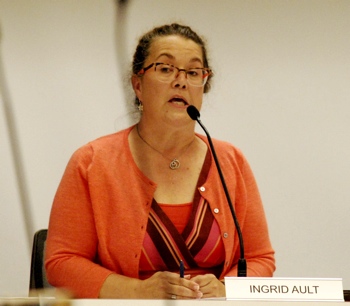
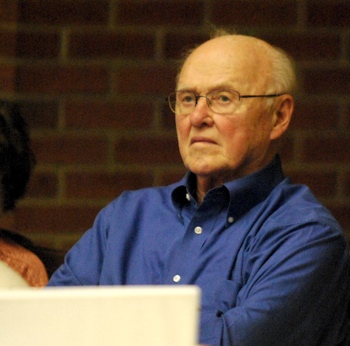
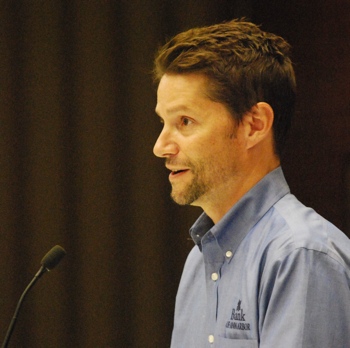

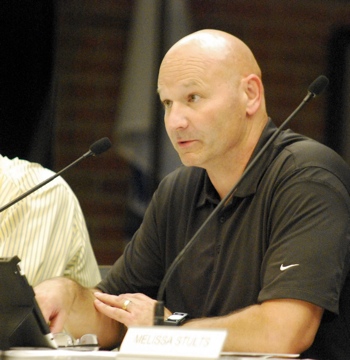
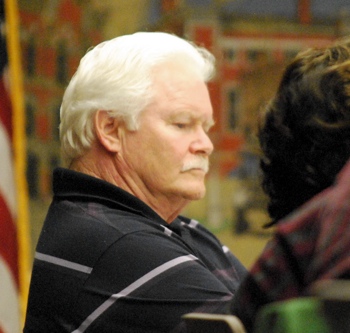
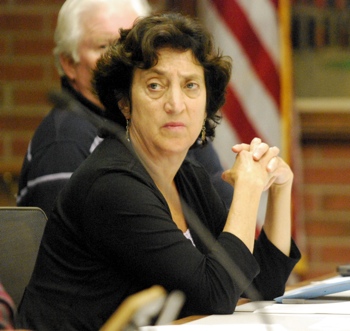
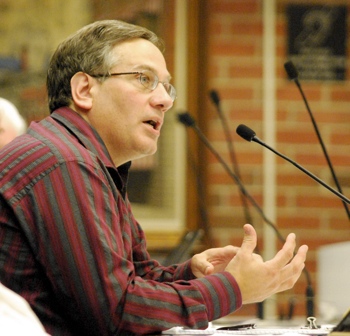
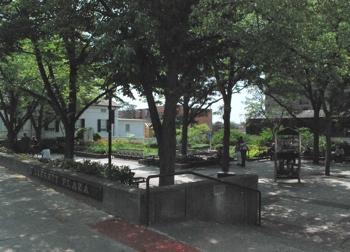
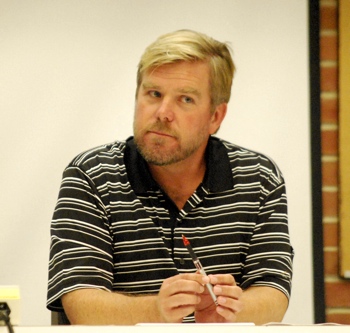
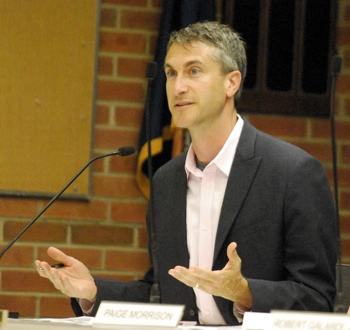
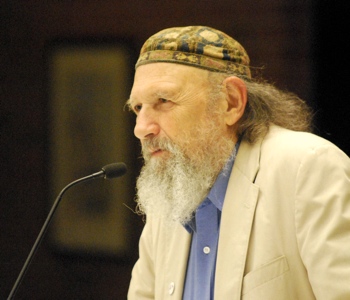
Regarding Liberty Plaza, I’d like to see SPARK shift their incubator space facing Liberty Plaza to another location and use that space as a startup incubator coffee house with garage doors that open up to the east to the lower part of Liberty Plaza a la Real Seafood Co.
It’s “place-making” that would make for better use of the park. It would provide an informal place for budding and established entrepreneurs to congregate, share ideas and help each other when they want to get out of their home, company or co-working offices instead of hanging out at random coffee houses all over town. Think of the serendipity that would ensue. I would think there are several coffee house proprietors who would bid for a chance to run such a business there, especially with Liberty Street turning into “entrepreneurs row”.
As for the Library Lane parking structure, I’m thinking “Winterfest” with “Bottom of the Park” performances. Run some wifi and cell repeaters down there on the lowest level, set up a stage, have people bring their own chairs, and listen to some music out of the cold up above ground during the nastiest part of the winter. And people who are nostalgic for dancing on a sloping parking structure floor like the original Top of the Park can get their fix. Food trucks/carts/booths and parking on levels above.
“Programming” is what you do for a successful park. It cannot save a poorly designed space. Having events once or twice a week in the summer (or even every day) will do zero to help create a different environment in the remaining 99% of the year. Don’t get me wrong: I’m glad Bank of Ann Arbor is doing events. But do they help the park the second the band leaves?
Take it as a cautionary tale for the misguided council decision to force a park in an even worse location right next door. Fast forward to three years from now: “Families intimidated by Library Plaza crowd; PAC weighs programming options.”
What a waste of volunteer time and community effort. When will council do their job and listen to what we, the community, asked for in our official Parks Plan? No more urban parks until we fix what we have.
#1 – Finally, someone addresses the elephant in the room. While the PAC is calling for “eyes on the park” in the case of the Library Lot, not one word has been said about just who is in the best position to keep their “eyes on the park” at Liberty Plaza, and that is SPARK. But you see, SPARK is not doing that, nor have they stepped forward to offer that service. No, SPARK takes care of SPARK, and that’s about it. They have been the immediate next door neighbor since at least 2007, and not once have we heard from them about taking any responsibility for the space. First Martin, the building owner, has done the bulk of the maintaining Liberty Plaza. Too bad our “economic development engine” SPARK can’t think of ONE way to help. It’s the least they could do.
Yet again the 2011-2015 Park and Recreation Open Space (PROS) Plan has been cited as basis for opposition to an urban park on the Library Lot. Supposedly the key part of the PROS plan is that future parks should not come at the expense of existing parks (described in the PROS findings as “taking care of what we have”). The implication is that this is a central finding of the 2011-2015 PROS Plan. This is not the first time that the anonymous “Liberalnimby” has made this assertion in an online comment. Interestingly, this same argument was offered during the recent primary campaign by one of the candidates for City Council.
Liberalnimby (and others) are misrepresenting the 2011-2015 PROS Plan when they claim it opposes creation of an urban park on the Library Lot. Their argument seems to consist of two parts: 1) the PROS Plan is a more definitive representation of public sentiment than other measures, and 2) the PROS Plan clearly states that “no new parks should be acquired until we adequately maintain existing parks first.”
The public process used in gathering input for the 2011-2015 PROS Plan included an online survey that received 822 responses. In the questions for which response data were provided a majority of respondents said that maintenance was “good” or “excellent” and they expressed satisfaction with existing facilities. Based on the PROS report, there was no specific survey question that posed a choice between existing and new parks. There were apparently no specific questions about downtown parks and open spaces in the PROS process (except for a hypothetical downtown dog park which received some favorable responses).
In comparison with the PROS Plan’s 822 survey respondents, the 2013 Parks Advisory Commission (PAC) Downtown Parks and Open Space survey had 1,608 respondents – twice the response received by the PROS survey. Of these, 76.2% (1,223 respondents) supported creation of additional downtown parks. Out of multiple choices they expressed clear preference for the Library Lot as the location for a new urban park. Based on numbers alone, the 2013 PAC citizen response outweighs the PROS Plan citizen response.
This concern about resources for existing parks was mentioned in some of the PROS focus groups discussions. The focus groups that expressed this concern as an element of their feedback were the City Planning Commission, Park Operations and Natural Area Preservation Staff, and the Recreation Advisory Commission. These particular constituencies would have been aware of the successive years of budget reductions for City parks. They would also have been more focused on existing maintenance needs. By way of contrast, none of the three public meetings held in the PROS process even mentioned this resource concern.
Does the 2011-2015 PROS Plan say anything specific about urban parks? Yes, page 118 of the PROS Plan states this goal: “Work with the Downtown Development Authority to plan for renovation and acquisition of downtown open space, including the development of the library lot.”
The Downtown Development Authority (DDA) took a big step in the direction of creating a public open space on the Library Lot. It designed part of the surface of the Library Lane parking structure to be the location of a future public plaza. Although there has been some confusion in the past about the exact dimensions of this space, we learned that the portion of Fifth Avenue frontage that is designed for a civic plaza (i.e. it lacks the reinforced footings to support construction above) is actually close to 8,000 square feet. City Council added a mere 4,000 square feet when it designated the full Fifth Avenue frontage for a public park.
Liberalnimby and others who say there should be no urban park on the Library Lot should find another argument besides the 2011-2015 PROS Plan. As far as the decision about locating a public plaza there, that location was baked into the construction of the Library Lane Parking Structure. City Council just made that urban park a little bit larger.
Re: 4)
Unfortunately, there has been an inconsistent adherence to the city’s master plans.
Unlike the Library Lot discussion, PAC has not referenced back to the PROS Plan or Non-Motorized Transportation Plan when they have discussed and approved the continued lease renewals of the supposedly “temporary”, Fuller Park parking lot leases to UM.
Several council members (Anglin and Eaton) have asked for PAC to readdress the lease contract but Taylor is citing the legal definition of council’s action (a postponement) versus sending it back to PAC for a more thorough review and discussion.
Whether we are talking about building a park on top of a parking structure or parking lots on top of a park, there needs to be a consistent review and public input process.